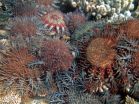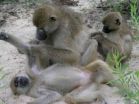(Press-News.org) The Great Barrier Reef has lost half its coral cover in the last 27 years. The loss was due to storm damage (48%), crown of thorns starfish (42%), and bleaching (10%) according to a new study published in the Proceedings of the National Academy of Sciences today by researchers from the Australian Institute of Marine Science (AIMS) in Townsville.
"We can't stop the storms but, perhaps we can stop the starfish. If we can, then the Reef will have more opportunity to adapt to the challenges of rising sea temperatures and ocean acidification, says John Gunn, CEO of AIMS.
"This finding is based on the most comprehensive reef monitoring program in the world. The program started broadscale surveillance of more than 100 reefs in 1985 and from 1993 it has incorporated more detailed annual surveys of 47 reefs," says one of the program's original creators, Dr Peter Doherty, Research Fellow at AIMS.
"Our researchers have spent more than 2,700 days at sea and we've invested in the order of $50 million in this monitoring program," he says.
"The study shows the Reef has lost more than half its coral cover in 27 years. If the trend continued coral cover could halve again by 2022. Interestingly, the pattern of decline varies among regions. In the northern Great Barrier Reef coral cover has remained relatively stable, whereas in the southern regions we see the most dramatic loss of coral, particularly over the last decade when storms have devastated many reefs. " says Peter Doherty.
The study clearly shows that three factors are overwhelmingly responsible for this loss of coral cover. Intense tropical cyclones have caused massive damage, primarily to reefs in the central and southern parts of the Reef, while population explosions of the coral-consuming Crown-of-thorns starfish have affected coral populations along the length of the Reef. Two severe coral bleaching events have also had major detrimental impacts in northern and central parts of the GBR.
"Our data show that the reefs can regain their coral cover after such disturbances, but recovery takes 10-20 years. At present, the intervals between the disturbances are generally too short for full recovery and that's causing the long-term losses," says Dr Hugh Sweatman, one of the study's authors.
"We can't stop the storms, and ocean warming (the primary cause of coral bleaching) is one of the critical impacts of the global climate change," says AIMS CEO, John Gunn. "However, we can act to reduce the impact of crown of thorns," he says. "The study shows that in the absence of crown of thorns, coral cover would increase at 0.89% per year, so even with losses due to cyclones and bleaching there should be slow recovery.
"We at AIMS will be redoubling our efforts to understand the life cycle of crown of thorns so we can better predict and reduce the periodic population explosions of crown of thorns. It's already clear that one important factor is water quality, and we plan to explore options for more direct intervention on this native pest."
INFORMATION:
Media contacts
Steve Clarke, AIMS Communication Manager, 07 4753 4264; 0419 668 497; s.clarke@aims.gov.au
Niall Byrne, Science in Public, 0417 131 977, niall@scienceinpublic.com.au
Background information including the paper, fact sheets on the study, the Great Barrier Reef and Crown-of-thorns; photos and video etc available at www.scienceinpublic.com.au/marine
The Great Barrier Reef has lost half of its coral in the last 27 years
Can we save the reef by controlling crown of thorns starfish?
2012-10-02
ELSE PRESS RELEASES FROM THIS DATE:
Tree rings go with the flow of the Amazon
2012-10-02
University of Leeds-led research has used tree rings from eight cedar trees in Bolivia to unlock a 100-year history of rainfall across the Amazon basin, which contains the world's largest river system.
The new study shows that the rings in lowland tropical cedar trees provide a natural archive of data closely related to historic rainfall.
Researchers measured the amounts of two different oxygen isotopes trapped in the wood's rings: oxygen-16 and the heavier oxygen-18. By looking at the varying amounts of the two isotopes, they could see how the pattern of rainfall ...
Sexually abused women much less likely to be screened for cervical cancer
2012-10-02
[Barriers to cervical screening in women who have experienced sexual abuse: an exploratory study 2012; 38: 214-20 (Research)
The effect of childhood sexual abuse on women's lives and their attitudes to cervical screening 2012; 38:1-2 (Editorial)]
Women who have been sexually abused as children or young adults are much less likely to get screened for cervical cancer than other women, indicates exploratory research published in the Journal of Family Planning and Reproductive Health Care.
Figures published last year by the national NHS Cervical Cancer Screening Programme ...
Misconduct, not error, accounts for most scientific paper retractions
2012-10-02
October 1, 2012 — (Bronx, NY) — In sharp contrast to previous studies suggesting that errors account for the majority of retracted scientific papers, a new analysis—the most comprehensive of its kind—has found that misconduct is responsible for two-thirds of all retractions. In the paper, misconduct included fraud or suspected fraud, duplicate publication and plagiarism. The paper's findings show as a percentage of all scientific articles published, retractions for fraud or suspected fraud have increased 10-fold since 1975. The study, from a collaboration between three ...
Potential new class of drugs blocks nerve cell death
2012-10-02
Diseases that progressively destroy nerve cells in the brain or spinal cord, such as Parkinson's disease (PD) and amyotrophic lateral sclerosis (ALS), are devastating conditions with no cures.
Now, a team that includes a University of Iowa researcher has identified a new class of small molecules, called the P7C3 series, which block cell death in animal models of these forms of neurodegenerative disease. The P7C3 series could be a starting point for developing drugs that might help treat patients with these diseases. These findings are reported in two new studies published ...
Homolog of mammalian neocortex found in bird brain
2012-10-02
A seemingly unique part of the human and mammalian brain is the neocortex, a layered structure on the outer surface of the organ where most higher-order processing is thought to occur. But new research at the University of Chicago has found the cells similar to those of the mammalian neocortex in the brains of birds, sitting in a vastly different anatomical structure.
The work, published in Proceedings of the National Academy of Sciences, confirms a 50-year-old hypothesis about the identity of a mysterious structure in the bird brain that has provoked decades of scientific ...
Penn researchers connect baboon personalities to social success and health benefits
2012-10-02
PHILADELPHIA — Whether human or baboon, it helps to have friends. For both species, studies have shown that robust social networks lead to better health and longer lives. Now, a team of University of Pennsylvania researchers has helped show that baboon personality plays a role in these outcomes, and, like people, some baboons' personalities are better suited to making and keeping friends than others.
The research was conducted by psychology professor Robert Seyfarth and biology professor Dorothy Cheney, both of Penn's School of Arts and Sciences. They collaborated with ...
A simple blood test could be used to detect breast cancer
2012-10-02
A SIMPLE blood test could one day be a more accurate way to test for the early signs of breast cancer than using mammograms to spot a lump say researchers today (Tuesday), as Breast Cancer Awareness Month gets underway.
They also hope the blood test could improve treatment by detecting whether breast cancer patients are likely to relapse and what drugs their particular type of tumour will respond to.
This pioneering new clinical study – funded by Cancer Research UK in collaboration with the University of Leicester and Imperial College London – is about to start in the ...
Breakthrough in understanding lung cancer vulnerabilities points the way to new targeted therapy
2012-10-02
More effective treatments for one of the deadliest forms of cancer are one step closer thanks to groundbreaking research from an international collaborative study.
Scientists from the Universities of Sheffield and Cologne have identified the dependencies of multiple Small Cell Lung Cancer (SCLC) types – paving the way for clinical trials of new targeted treatments which could revolutionise the current approach.
Around 40,000 people are diagnosed annually with lung cancer in the UK, and SCLC accounts for nearly one in five of all these cases.
Unfortunately, the prognosis ...
Severely obese are fastest growing group of overweight Americans, study finds
2012-10-02
The proportion of Americans who are severely obese -- those people 100 pounds or more overweight -- continues to increase rapidly and much faster than those with moderate obesity, but the rate of growth has slowed, according to a new RAND Corporation study.
The RAND study found that from 2000 to 2010, the proportion of Americans who were severely obese rose from 3.9 percent of the population to 6.6 percent -- an increase of about 70 percent.
The findings mean that more than 15 million adult Americans are morbidly obese with a body mass index of 40 or more. The good ...
Meeting pigs' phosphorous requirements with fermented soybean meal
2012-10-02
Fermented soybean meal (FSBM), considered a promising substitute for fish meal in weanling pig diets because of its protein content, lower cost, and lack of anti-nutritional factors, may have an additional advantage. University of Illinois researchers recently found that pigs digest the phosphorous in FSBM better than the phosphorus in conventional soybean meal.
"Most of the P in soybean meal is bound to phytate, so it's not available to pigs," explained animal sciences professor Hans Stein.
Previous research by Stein's group found that pigs digest the phosphorous in ...
LAST 30 PRESS RELEASES:
The perfect plastic? Plant-based, fully saltwater degradable, zero microplastics
Bias in data may be blocking AI’s potential to combat antibiotic resistance
Article-level metrics would provide more recognition to most researchers than journal-level metrics
Satiety’s little helper: Protein that supports appetite regulating protein identified
UF dives deep into predicting storm damage with computer models
A stormy ocean voyage yields insights on the global carbon cycle
Scientists identify first non-coding gene that controls cell size
Demonstration of altermagnetism in RuO₂ thin films -- A new magnetic material for the AI era
Penn researchers awarded $25M to conduct trial using smartphones to fight heart disease
PCORI awards funding for new patient-centered healthcare research
Exploring the origins of the universe: 145 low-noise amplifiers complete ALMA telescopes
Empress cicada wings help illuminate molecular structure
Using sound waves to detect helium
Time burden in patients with metastatic breast and ovarian cancer from clinic and home demands
Researchers discover bias in AI models that analyze pathology samples
Scientists ID potential way to prevent brain injuries from triggering Alzheimer's
MASTER 2nd Open Call: Execution period kick-off
Algae for health in food and pharma
Advanced microrobots driven by acoustic and magnetic fields for biomedical applications
Chicago health information leader recognized for raising CPR readiness and blood pressure awareness
The Intimate Animal, a new book from Kinsey Institute Executive Director Dr. Justin Garcia
When blue-collar workers lose union protection, they try self-employment
New video dataset to advance AI for health care
MEA-based graph deviation network for early autism syndrome signatures in human forebrain organoids
New modeling approach sheds light on rare gut disease
Study documents potentially hazardous flame retardants in firefighter gear
Can certain bacteria regulate aging of the immune system and its related alterations?
AI model helps diagnose often undetected heart disease from simple EKG
There are fewer online trolls than people think
Cell membrane fluctuations produce electricity
[Press-News.org] The Great Barrier Reef has lost half of its coral in the last 27 yearsCan we save the reef by controlling crown of thorns starfish?

